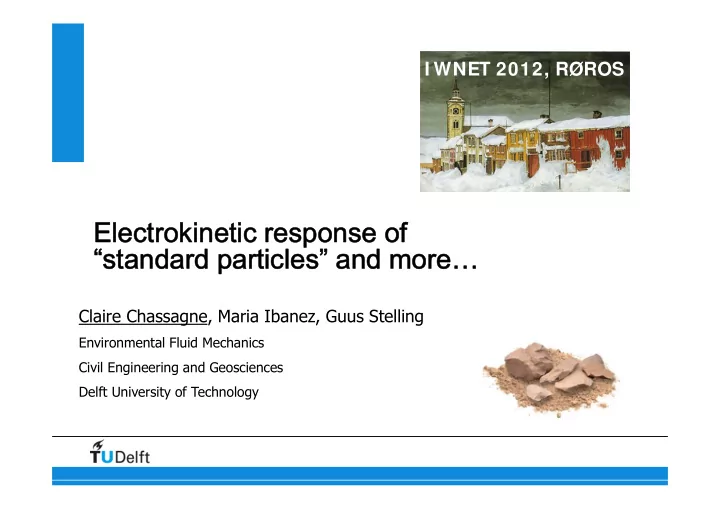

I WNET 2012, RØROS Electrokinetic response of “standard particles” and more… Claire Chassagne, Maria Ibanez, Guus Stelling Environmental Fluid Mechanics Civil Engineering and Geosciences Delft University of Technology
System 1) “standard”particles : constant charge = 0,04 C/m^2 (sulfate latex) radius = 265 nm (TEM) monodisperse Suspending medium: demi-water + salts
System 2) “more” = non-spherical particles : kaolinite, gibbsite, goethite (clays, oxides) non-ideal
Zeta Potential |ZP| = | ζ | < 25 mV AGGREGATE particle slip plane where of charge the zeta potential ζ |ZP| = | ζ | >> 25 mV Q is defined ζ =f(Q) STABLE
Application zeta pot. > interactions > rheology
Application
Assumptions T = constant (no “thermo-dynamic”) E = applied electric field (but “electro-dynamic”) E (V/cm) << zeta potential (mV)/ double layer (nm) X = Xeq + dX double layer (ion cloud) (zeta potential) Shear plane = surface particle :
Relation charge / potential at eq. We will assume a constant surface charge : fixe charge => find the zeta potential for each ionic strength using (PB) + bisection method
Surface potential / added salt in case of a constant charge -16 SIG=0.04 KCl SIG=0.04 MgCl -14 -12 surface potential (-) -10 -8 -6 -4 -2 0 0.0001 0.001 0.01 0.1 1 10 100 1000 added salt (mM)
constant surface potential The shear plane is at d(nm) from the surface The zeta potential ζ = potential at shear plane Constant surface potential but zeta potential decreases with ionic strength when d ≠ 0
Standard electrokinetic equations Poisson : Conservation of mass: Note:
Standard electrokinetic equations Boundary conditions Potential : No flux: u ( ∞ ) = - U No slip:
Electrophoresis standard electrokinetic equations relation electrophoretic mobility / zeta potential: found from (PB) assuming (given) constant charge found with no adjustable parameter found from solving numerically the set of standard electrokinetic equations
Electrophoresis constant zeta potential ZP = 0.1x25 mV Smoluchowsky limit = 1 Analytical (Henry / Ohshima) Debye limit = 2/3 Analytical (O’Brien / Hunter) symbols: num. simulations ZP = 6x25 mV κ a
Electrophoresis / added salt constant charge = x
Electrophoresis / added salt constant charge 0 no adjustable parameter -10 -20 ZP (mV) -30 (mV) -40 -50 -60 0.000001 0.00001 0.0001 0.001 0.01 0.1 1 10 100 added mM of MgCl2
Electrophoresis / added salt constant charge 0 -10 -20 -30 ZP (mV) -40 -50 -60 MgCl2 ZetaSizer theory MgCl2 theory with d = 0,25 nm -70 same behavior for 2800 nm theory sigma = 2,5 d-2 C/m^2 Smoluchowski spheres (Kobayashi, Colloid -80 0.000001 0.0001 0.01 1 100 10000 Polym Sci (2008) 286:935–940) added mM of salt
Electrophoresis / added salt constant charge Gittings and Saville, Colloids and Surfaces A (1998) 0 high > low -10 low > high NUM -20 OHSHIMA -30 -40 ZP (mV) -50 -60 -70 -80 -90 curvature! -100 0.0001 0.001 0.01 0.1 1 10 100 1000 [KCl] (mM)
Hairy layer : Particle size / added salt DLS and TEM Gittings and Saville, Colloids and Surfaces A particle concentration: 19 mg/L (1998) 305 ZetaNano 300 Zeta3000 295 290 radius (nm) 285 280 275 270 TEM 265 260 0.00001 0.0001 0.001 0.01 0.1 1 10 100 [ KCl ] (mM)
Electrophoresis / particle concentration 0 no added salt 1,5 mM KCl -10 0,1 mM MgCl2 1 mM MgCl2 -20 no added salt ZetaSizer 3000 “salt-free” -30 ZP ≈ - log (1/ Φ ) -40 ZP (mV) -50 Ohshima, Journal (mV) -60 of Colloid and Interface Science -70 247, 18–23 -80 (2002) -90 -100 0.1 1 10 100 1000 particle concentration (mg/L)
Summary for spheres - Standard theory describes reasonably well the electrokinetic behavior of the latex particles, with no adjustable parameter (electrophoresis, dielec. spectro., conductivity) - adding a Stern layer conductance does not improve the fit => hairy layer (“soft particles”) could be explanation for shifting the shear plane approx. 0.25 nm from the particle surface - behavior as function of particle volume fraction follows prediction for nearly no salt
Outlook electrokinetic response of spheroidal particles 2008 : => analytical solution (reproduce O’Brien + Loewenberg) 2012 : => numerical solution (=> improve analytical solution)
Prolate spheroids (cigars)
Prolate spheroids (cigars) 60 5 4 40 3 electrochemical 2 20 1 potential counterions 0 0 -1 -20 -2 -3 -40 -4 -5 -5 0 5 -60 -60 -40 -20 0 20 40 60 P H I1 PH I1 60 5 4 40 3 electrochemical 2 20 1 potential co-ions 0 0 -1 -20 -2 -3 -40 -4 -5 -60 -5 0 5 -60 -40 -20 0 20 40 60 PH I2 PH I2
Oblate spheroids (mentos)
Doppler electrophoresis at low volume fraction (original vol. frac. = 0.6%) Gibbsite (original conc. : 16 mg/L) 30 20 10 0 0,001 0,01 0,1 1 10 100 1000 -10 - Zeta potential (mV) -20 -30 -40 Na2SO4 (1/80) Na2SO4 (1/60) -50 Na2SO4 (1/40) volume fraction -60 Na2SO4 (1/20) -70 concentration salt(mM)
Recommend
More recommend